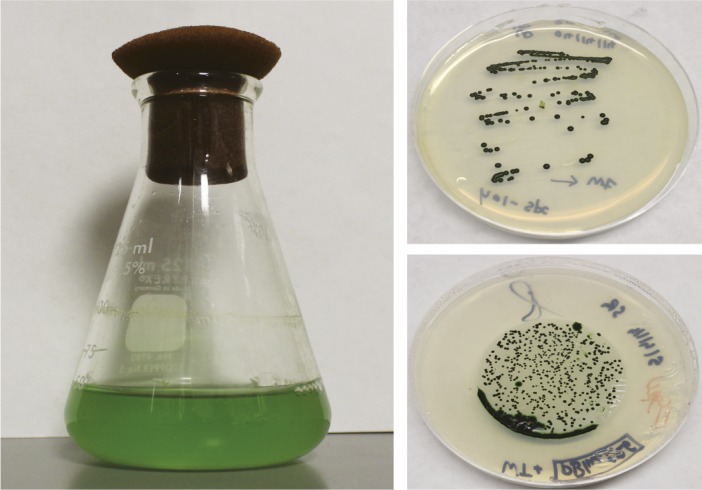Microbes engineered to produce plant metabolites

Cyanobacteria liquid culture (Left) and colonies (Right).
Plant metabolites can be beneficial to human health but are often difficult to produce and isolate in large quantities. Photosynthetic microbes provide a possible alternative for large-scale production of such plant compounds. Yong Xue et al. (pp. 9449–9454) engineered a photosynthetic microbe, the cyanobacterial strain Synechocystis sp. PCC 6803, to produce p-coumaric acid, a precursor of phenylpropanoid compounds, which possess antioxidant, antiviral, and anti-inflammatory properties. To create the strain, the authors introduced a tyrosine ammonia lyase gene from an actinomycete bacterium and deleted a polyphenol oxidase gene from the cyanobacterial genome. Whereas the original strain did not produce p-coumaric acid, the engineered strain produced 82.6 mg of p-coumaric acid per liter of growth medium. The p-coumaric acid was successfully extracted and purified from the cyanobacteria’s growth medium. According to the authors, the study suggests that the engineered cyanobacterial strain may provide a means to produce beneficial plant metabolites at rates higher than those at which the metabolites can be extracted from plants. — J.P.J.
Division of labor in a social spider

Social spider species, Anelosimus studiosus. Image courtesy of Judy Gallagher (photographer).
Division of labor based on morphological or physiological characteristics of individuals within groups of social organisms is well-documented, but whether differences in behavioral tendencies influence the group tasks that individuals perform remains unclear. Colin Wright et al. (pp. 9533–9537) searched for potential links between animal behavioral tendencies, division of labor, and task proficiency in the social spider Anelosimus studiosus, a species whose female members display either an aggressive or docile behavioral dimorphism. The authors created laboratory colonies composed of two aggressive and two docile female spiders and examined division of labor. Aggressive females engaged in colony defense, prey capture, and web repair at nearly three times the frequency of docile females, whereas docile females engaged in brood care at three times the frequency of aggressive females. Outside of a colony environment, individual aggressive females outperformed individual docile females in colony defense, prey capture, and web repair, whereas docile females outperformed aggressive females in brood care. According to the authors, the results suggest that species may exhibit division of labor based on behavioral and morphological polymorphisms. — J.P.J.
Fire, predation, and seed release timing

Red squirrel feeding on a lodgepole pine cone.
Ecological pressures that operate on short time scales, such as predation and fire, can influence the long-term evolution of landscapes. Matthew Talluto and Craig Benkman (pp. 9543–9548) examined the interplay between wildfire frequency and seed predation on the occurrence of serotiny, the ability of some trees to release seeds after an environmental trigger such as fire, in Rocky Mountain lodgepole pines across the Greater Yellowstone Ecosystem. The authors measured pine cone abundance and the density of the American red squirrel, a common seed predator, for a period of 1 year, and found that serotinous lodgepole pinecone abundance was low in areas with high squirrel density but high in areas with high fire frequency. The results suggest that wildfires favor the survival of serotinous pines, which are more vulnerable to squirrel predation than nonserotinous pines. However, in areas with both high fire frequency and high seed predation, nonserotinous lodgepole pines dominated the landscape. According to the authors, landscape models indicate that the evolution of serotiny in lodgepole pines has been shaped by the interplay between fire and seed predation frequencies across the landscape. — J.P.J.
Genome editing helps generate HIV-resistant stem cells

Genome editing for HIV-resistant stem cells. Image courtesy of iStockphoto/zmeel.
Individuals with a mutation in both alleles of a gene called CCR5, which encodes a human cellular receptor for HIV, are resistant to infection by the AIDS virus and represent a potential source of stem cells for transplantation to patients. However, the low frequency of such individuals in the human population, challenges tied to immunological compatibility, and risks of transplantation-related immunosuppression render this therapeutic approach daunting. Using a combination of transposon-based tools and two genome editing techniques—TALENs and CRISPR-Cas9—Lin Ye et al. (pp. 9591–9596) introduced the HIV resistance-conferring mutation in both alleles of the CCR5 gene in induced pluripotent stem cells (iPSCs) reprogrammed from peripheral blood mononuclear cells from two donors. The authors report that TALENs generated biallelic mutant iPSCs at an average rate of 14%; the corresponding rate for CRISPR-Cas9 was 33%. Further, monocytes and macrophages derived from the mutant iPSCs showed resistance to the replication of an HIV-1 strain in laboratory dishes, compared with susceptible monocytes and macrophages derived from wild-type iPSCs. Because iPSCs can help generate large numbers of patients’ own helper T cells, HIV’s primary target, and can be monitored for genomic integrity, this genome editing approach might be advantageous over previous approaches, according to the authors. — P.N.
Database for plant genome annotation and modeling

Arabidopsis lyrata, one of 10 plant genomes in the PlantSEED database. Image courtesy of Wikimedia Commons/Fritzflohrreynolds.
The SEED database is an open access resource for annotation, comparative analysis, and metabolic modeling of microbial genomes, with tools for refining genome annotations and comparing biological functions across many species. Samuel Seaver et al. (pp. 9645–9650) expanded SEED to enable similar analysis of plant genomes and tested the system using 10 plant genomes. The database, called PlantSEED, integrates gene sequences, gene annotations from the literature, and biochemical data from seven separate plant genome databases to provide a framework for rapid gene annotation, automated modeling of metabolic processes in plants, and comparison of gene function between plants and prokaryotes. Like SEED, PlantSEED employs a subsystems approach to gene annotation in which genes are grouped together based on their involvement in a particular metabolic process, thereby reducing errors and inconsistencies that can arise in a gene-by-gene annotation approach, according to the authors. Comparative analysis of the 10 plant genomes currently in the database revealed annotation inconsistencies that were corrected, and metabolic models identified missing annotations for which candidate genes were suggested. Final versions of the metabolic models were functional, suggesting that PlantSEED accurately identified annotation errors. According to the authors, PlantSEED might help integrate data, speed annotation, and construct accurate biochemical models for a burgeoning number of plant genomes. — J.P.J.
MicroRNAs and HIV infection
MicroRNAs (miRNAs) are small RNA molecules that regulate cellular processes, usually by reducing gene activity. However, recent evidence suggests that miRNAs also interact with proteins in a process that does not involve gene silencing. To explore whether miRNAs can interact with HIV-1 proteins to control infection, Antony Chen et al. (pp. E2676–E2683) expressed HIV-1 RNA and HIV-1 proteins in human cells that either were or were not induced to generate high levels of human miRNAs. Cells with high miRNA levels produced fewer infectious viral particles than cells with normal miRNA levels. To produce this effect, the miRNAs interfered with the actions of an HIV-1 protein called Gag, which typically forms viral particles by binding to viral RNA and assembling at the plasma membrane of host cells. Both the interactions between Gag and viral RNA as well as Gag assembly at the plasma membrane were disrupted in miRNA-overexpressing cells, compared with normal cells. According to the authors, the findings suggest that increasing overall levels of miRNAs rather than targeting specific miRNAs alone might represent a strategy for combating HIV-1 transmission and infectivity. — J.W.


